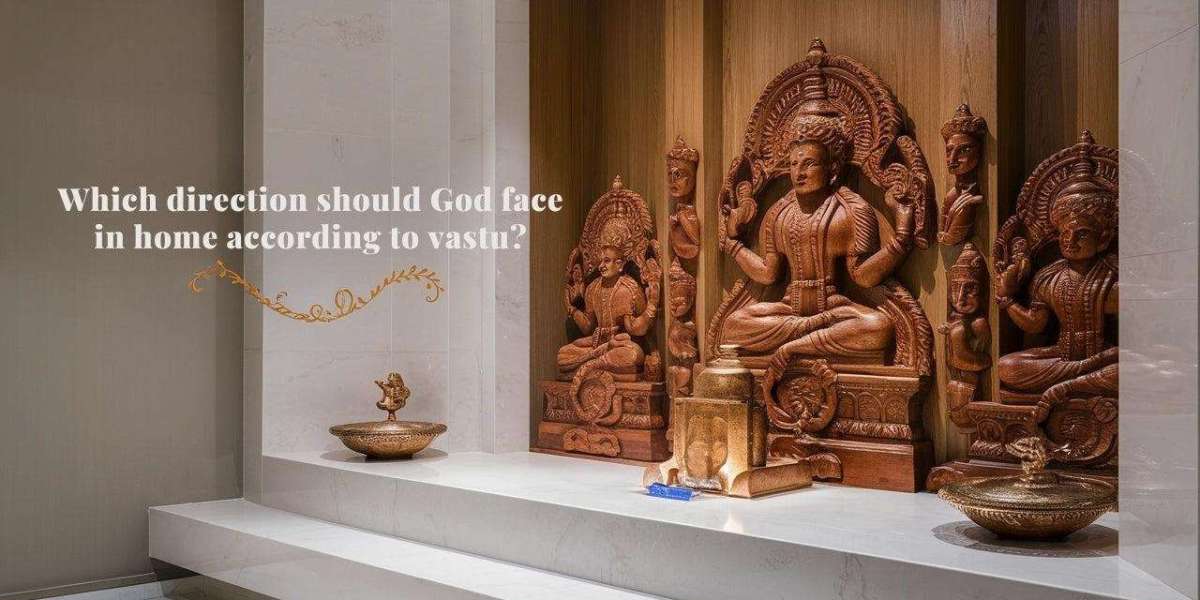Choosing the correct direction for placing a God idol or picture at home affects peace, harmony, and positive energy. Following the ancient science of God face in home as per Vastu, homeowners have always sought divine alignment for their pooja room or sacred space.
Understanding Vastu Shastra for Divine Placement
Vastu Shastra acts as a guiding science that aligns energies of space with the universe. It emphasizes the balance of five elements: earth, fire, water, air, and space. By aligning deities in the correct direction, the flow of these energies becomes harmonious.
This balance enhances mental peace, success, and spiritual connection. The goal of Vastu remains simple—align your home with natural forces to experience divine blessings.
Ideal Direction for God Face in Home as per Vastu
Vastu Shastra suggests very specific directions for placing God idols. Each direction holds specific energy based on the ruling element and deity. The northeast corner, known as Ishan Kon, holds the most sacred value in Vastu. This direction supports meditation, prayer, and concentration.
God face in home as per Vastu must align toward the east or northeast. These directions ensure morning sunlight energizes the pooja space. Facing east also symbolizes clarity, beginnings, and divine awakening.
Significance of Northeast Corner (Ishan Kon)
The northeast, governed by Lord Shiva, offers divine energy and spiritual depth. A pooja room in this corner invites calmness and devotion. When you sit facing east while praying, your energy synchronizes with nature.
Avoid placing the temple in the southwest or directly in front of the bathroom or kitchen. These areas do not promote sacred vibrations.
Which Deity Should Face Which Direction?
Vastu allows some flexibility in placement depending on the deity. Follow these directions to maximize energy flow:
Lord Shiva: Face west; sit facing east
Lord Vishnu: Face east
Goddess Lakshmi: Face east
Lord Ganesha: Face west
Durga/ Kali: Face south
Always ensure the deities do not face each other. Each idol should have enough space and proper lighting around it.
Right Direction for Pooja Room Placement
The overall pooja room placement holds equal importance. If your home layout allows, position the pooja room in the northeast part of the house. If not possible, the east or north also works well. Avoid the south and southwest parts of your home.
Keep the pooja space clutter-free and elevated from the ground. Light a diya or lamp in the southeast corner of the temple.
Placement Tips Based on Home Layout
Every home layout differs, but Vastu principles remain universal. Here’s how you can apply them in different parts of the house:
Living Room: Northeast corner works best. Ensure visibility but maintain cleanliness and respect.
Kitchen: Avoid placing gods here. If necessary, use the northeast shelf at a height.
Bedroom: Vastu discourages placing deities in the bedroom. If necessary, cover them with a curtain while sleeping.
Under the Stairs: Never place idols here. This area does not carry sacred vibrations.
Follow symmetry while arranging idols and maintain equal spacing between them. Avoid chipped or damaged idols.
Material and Size of Idols as per Vastu
Choose idols made of marble, brass, or wood. These materials hold positive energy and durability. Keep idol sizes moderate. Very large statues can dominate the space, while very small ones might not channel energy properly.
Avoid black-colored idols for the main prayer area. Choose soft and natural tones that reflect serenity.
Sacred Geometry and Temple Design
Vastu also speaks about mandalas and geometry in temples. A square or rectangular pooja room layout works best. Use a gopura or dome structure at the top if space permits. It symbolizes ascension of prayer.
Keep pooja rooms away from noisy areas. Install a wooden door with two shutters. Carve religious symbols like Om or Swastik on the entrance.
Ritual Items and Their Vastu Placement
Here’s how to arrange common pooja items according to Vastu:
Diya Stand: Southeast direction
Water Vessel (Kalash): Northeast corner
Incense Holder: East or north
Bell: Near entrance of temple
Photos of Ancestors: Avoid placing them with God idols
Use natural flowers and ensure the daily cleaning of all pooja articles.
Daily Practices for Maintaining Positive Energy
The energy around your God idols depends not only on placement but also on daily discipline. Chanting mantras, lighting lamps, and keeping fresh flowers add to the sacred environment.
Meditate in the same direction each day to strengthen focus. Regular cleaning and avoiding clutter also help retain energy alignment.
Common Mistakes to Avoid in Temple Vastu
Even a minor mistake in deity placement can disrupt household harmony. Avoid these common errors:
Never place idols near the bathroom or attached to its wall.
Avoid using a shared wall with the bedroom or kitchen.
Don’t keep broken idols or torn pictures.
Never store money or valuables inside the pooja room.
Respect and discipline enhance the power of correct placement.
Direction for Sitting and Praying
As important as the idol direction is your sitting direction during prayer. Face east or north while praying. This aligns your body with magnetic energy fields and strengthens spiritual energy.
Avoid facing south at any cost. This direction draws energy downward and may affect your focus.
Best Lighting and Ventilation for Pooja Room
Proper lighting allows spiritual energy to circulate freely. Natural sunlight in the morning brings positivity. Use yellow or warm lights to add a divine glow. Place a window in the east wall if possible.
Air circulation ensures freshness. Light camphor or dhoop to purify the environment.
Role of Colors in Enhancing Vastu Energy
Color therapy also works with Vastu. For pooja rooms, choose light shades like white, cream, pale yellow, or soft pink. These tones enhance calmness and invite divine presence.
Avoid bright red, dark grey, or black for walls and flooring. Always maintain a soft and sacred appearance in your temple space.
Direction for Havan or Sacred Fire Rituals
During havans or sacred fire rituals, face east. Place the fire altar in the southeast direction. This direction balances the fire element (Agni). Everyone should sit around the fire with heads pointing east.
Keep copper or brass utensils for offerings. Use dry wood, cow dung cakes, and ghee for the sacred fire.
Best Time to Perform Pooja
The early morning hours, just after sunrise, provide the highest spiritual vibrations. The east-facing direction catches these first rays of light, empowering your prayers.
Evening prayers should happen at sunset, facing the same direction. Consistency strengthens energy over time.
Customizing Pooja Spaces in Modern Apartments
Even compact apartments can accommodate a pooja space. Choose the northeast corner of the living or dining room. Install a small wooden temple on a mounted shelf if floor space is limited.
Avoid placing it next to the refrigerator, sink, or washing machine. Keep electronic distractions away from the divine zone.
Conclusion
Choosing the God face in home as per Vastu does more than follow tradition. It builds a connection between spiritual energy and daily life. By following the right direction, materials, placement, and practices, you invite prosperity, harmony, and peace into your home.
For any assistance with Vastu-based home planning or interior consultation, contact us. We at Housiey ensure that your space aligns with energy, intention, and divinity.
Frequently Asked Questions
1. Which direction should God face in the home as per Vastu?
God should ideally face east or northeast as per Vastu, which promotes positive energy and divine connection.
2. Can I place the pooja room in the bedroom?
It's not recommended, but if necessary, place it in the northeast corner and cover the temple area with a curtain while sleeping.
3. Which direction should I face while praying?
You should face east or north while praying to align yourself with cosmic energy.
4. Is it okay to place idols under the staircase?
No. Vastu strictly advises against placing idols under staircases as that space lacks spiritual energy.
5. Can we keep God idols in the kitchen?
Avoid it unless there's no other space. If necessary, place the idol on a clean, elevated shelf in the northeast corner.
6. What are the best materials for God idols?
Marble, brass, and wood are considered ideal materials for idols as per Vastu Shastra.
7. Can I place photographs of ancestors in the pooja room?
No. Keep ancestors' photos separate from deities, preferably in the southwest direction of the home.
8. What color is best for the pooja room?
Light shades like white, cream, soft pink, or pale yellow enhance peace and spiritual vibes.
9. Can I keep a broken idol in the temple?
No. Vastu suggests removing damaged or chipped idols immediately, as they disrupt spiritual harmony.
10. What is the best time for daily prayers?
Morning prayers at sunrise and evening prayers at sunset are considered most auspicious.


